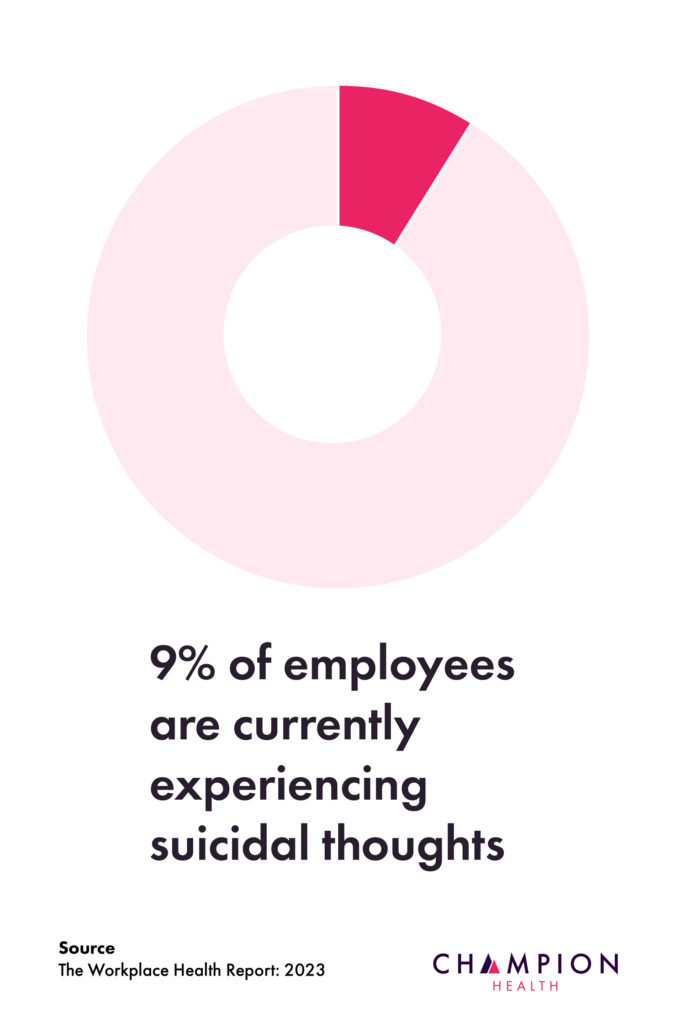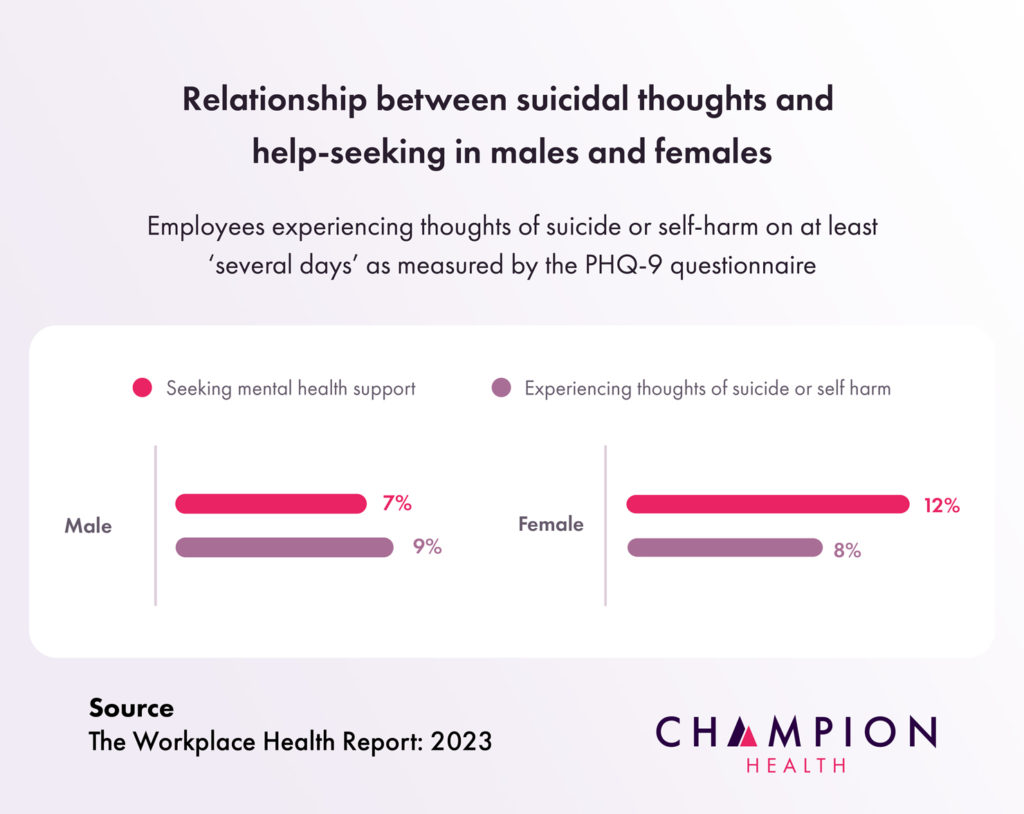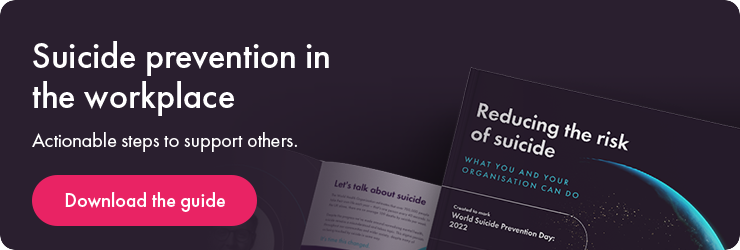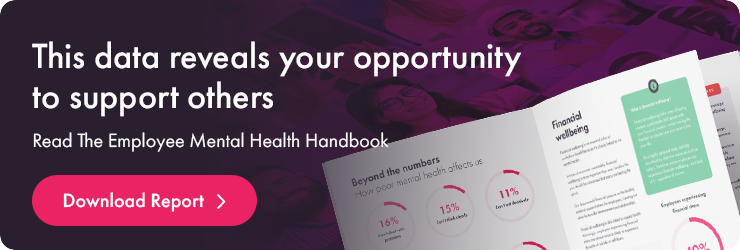According to Samaritans, understanding suicide statistics can help us to better target action and prevent suicide.
And tragically, action to prevent suicide is sorely needed. Research shows that suicide presents an international public health challenge. These effects have also permeated into our workplaces, with suicides relating to workplace issues also rising.
In this article, we’re going explore how prevalent thoughts of suicide and self-harm are – both within the wider population and our workforces.
Note: Looking for statistics on mental health more broadly? Read this article for a comprehensive look at mental health statistics.
Suicide statistics
Below, we’ve summarised the most up-to-date data available around suicidal thoughts statistics – as well as statistics around instances of suicide and thoughts of self-harm. This data will be regularly amended to reflect the latest research.
Here are the latest suicide statistics, including suicide and self-harm:
- Over 700,000 people take their own life each year – that’s one person every 40 seconds (World Health Organization)
- 115 people die by suicide in the UK every week – with 75% of those deaths being male (ONS)
- 1 in 5 people have suicidal thoughts (NHS Digital)
- 1 in 14 people self-harm (NHS Digital)
- 1 in 15 people attempt suicide (NHS Digital)
- Males aged 45-49 have the highest suicide rate (Samaritans)
- 10% of young people self-harm (Mental Health Foundation)
The experts at Champion Health have also analysed data that looks at the prevalence of thoughts of suicide and self-harm within the workplace. Read on to discover these statistics.
Suicide statistics within organisations
This year, Champion Health revealed the prevalence of thoughts of suicide and self-harm among employees in the Workplace Health Report.
We set out to discover the health challenges faced by UK employees in every area of wellbeing, from stress to financial wellbeing, musculoskeletal health, energy levels and beyond.
We also explored the impact of financial stress on employee wellbeing in: Cost of Living Crisis: Financial Stress and Employee Wellbeing.
For both reports, using clinically validated measures, the team analysed the anonymous data of thousands of employees, across a range of sectors and demographics.
The result was a comprehensive range of employee wellbeing statistics, with the data around thoughts of suicide and self-harm showing:
- 9% of employees are currently experiencing thoughts of suicide or self-harm
- Female employees are almost twice as likely as male employees to seek mental health support
- Employees experiencing financial stress are twice as likely to experience thoughts of suicide or self-harm
Read on to explore these findings in more detail.
1. 9% of employees are experiencing thoughts of suicide or self-harm
Champion Health’s research found that 9% of employees are currently experiencing thoughts of suicide or self-harm.

Our data also shows that year-on-year, the number of employees experiencing thoughts of suicide or self-harm has increased from 8% to 9%.
This means that, in an average organisation of 1,000 employees, there are 90 individuals
experiencing thoughts of suicide. Put another way, 10 more people in that organisation are now experiencing suicidal thoughts versus last year.
These figures highlight the critical role that employers must play in preventing cases of employees taking their own lives.
Read the following guide to discover what you – as an organisation, employer or colleague – can do to prevent instances of suicide: suicide prevention in the workplace.
2. Female employees are almost twice as likely as male employees to seek mental health support
Despite our data showing that the prevalence of thoughts of suicide and self-harm are similar among genders, far fewer male employees are seeking support. Only 7% of male employees are currently seeking mental health support, compared to 12% of female employees.

With research by ONS showing that men are three times more likely to take their own lives than women, there is a clear need for organisations to prioritise reducing the stigma around male mental health in the workplace.
Employers must continue to focus on opening up the conversation around male mental health, and make the support that is available visible, accessible and stigma-free.
Access the following resources for ideas and guidance around how this can be done:
- Watch: Mental health training for leaders
- Watch: Talking about mental health: the leadership edition
- Read: Talking about Mental Health in a Staff Appraisal or 1:1
- Guide: Suicide Prevention in the Workplace
3. Financial stress is linked with self-harm and suicidal thoughts
Champion Health’s data reveals that employees experiencing financial stress are twice as likely to experience thoughts of suicide or self-harm.
The data aligns with research from the UK’s Money and Mental Health Policy Institute, showing that those who have recently experienced a financial crisis are almost eight times more likely to experience suicidal thoughts than those who have not.
What you can do to reduce suicide
Suicide prevention will always be close to the heart of Champion Health. In 2018, our CEO and co-founder Harry Bliss lost his mentor to suicide, following a short bout of stress.
It is his legacy that has driven Champion to where it is today, and suicide prevention is something that will always drive the business.
Watch this video to find out more about Harry’s story.
As friends, leaders, managers and colleagues, we all have a vital role in preventing cases of suicide. You don’t have to become a GP, counsellor or mental health expert to make a huge difference.
If you or someone you know is experiencing suicidal thoughts, contact one of the services in the graphic below.
For organisations wanting to make a difference, Harry recommends they take the following actions:
- Train your team in mental health (there are many cost-effective ways to do this)
- Embed wellbeing into every employee survey
- Make wellbeing a KPI at board level
- Get every director to sign a pledge to support employee mental health
- Effectively communicate your wellbeing strategy and initiatives
If you’re concerned about a colleague, access these resources for guidance and advice.
- How to support a colleague in crisis
- How to talk about mental health at work
- Depression in the workplace | How to Support Your Employees
- The CLASS Approach: how to support others
- How to spot mental health issues at work
As Harry says, “By coming together collectively, we can change and save lives. If you already know you’re doing everything you can as an organisation to support your employees and prevent incidences of suicide, thank you. Thank you from the people you’ve helped when they needed you the most.”








